The Shkrub House is a project by Sergey Makhno Architects, for the family of Sergey Makhno himself. Located in Kozyn, a village in the suburbs of Kyiv, Ukraine, the unusual home measures in at 370 square metres. It was here that Sergey Makhno began his architectural journey more than 15 years ago, before he chose to live here. The new house design is evolved from two distinct aesthetics, one being a contemporary Ukrainian style sprung from old traditions, and the second being the Japanese philosophy of wabi-sabi that finds beauty and harmony in imperfection. A modernised take on a thatched roof overhangs wooden wall slats across the exterior, building character, though nothing compares to what lies within…
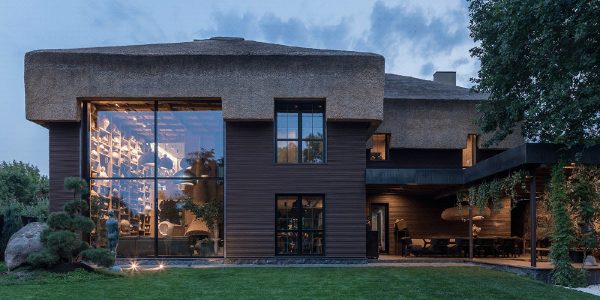
Sergey Makhno reflects on the journey of his home design: “Thanks to Japan, I learned to love Ukraine. When I went to Japan for the first time and saw how they appreciate their heritage, I understood that Ukrainian culture is extremely rich but we rarely rate it highly. Japan has given my country back to me. It has opened my eyes and, most importantly, my heart to the wealth I have always had–my homeland. Even if I wanted to do Japanese design–it would not work. Because I’m Ukrainian. I create Ukrainian design transmitted through the lens of Japanese perception of beautiful”. A sculptural figure, “Rain” by Nazar Bilyk, gazes up at the family home, guarding the family.
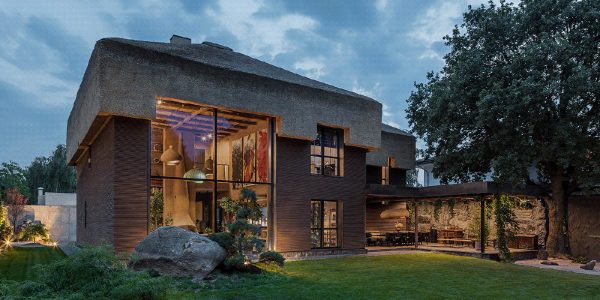
A Zen garden springs up around the modern exterior. Much of the garden flourished without human hand, growing on wasteland around the site over the course of a few months–apt to the Japanese belief that the stone itself must choose where to lie. The natural habitat drew in squirrels and nightingales to live amongst it. An awesome window breaks the interior open to the outside.
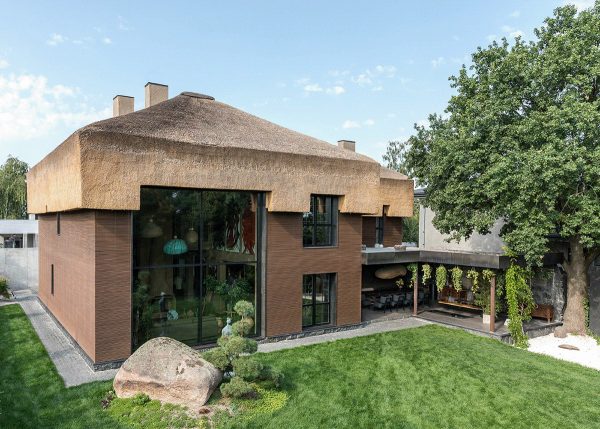
The home is almost completely surrounded by a minimalist concrete enclosure. It has two entrances, one from the façade and another from the courtyard that the family have fallen in love with. Entering the home via the courtyard walks you past an attractive terrace that is illuminated with designer lamps created by Sergey Makhno.
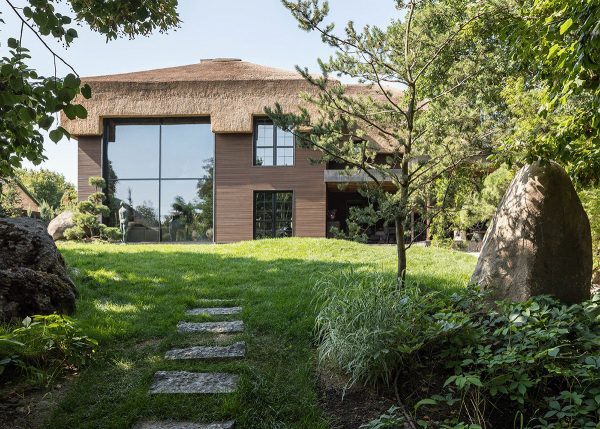
A stone path enters the garden gallery through Japanese maples and cherry trees.
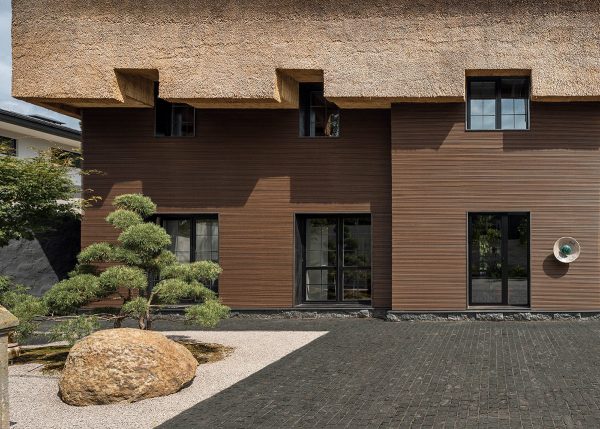
Thatching and wood are architectural materials traditional in both Ukrainian and Japanese cultures, and so became a fitting choice for this melded design.
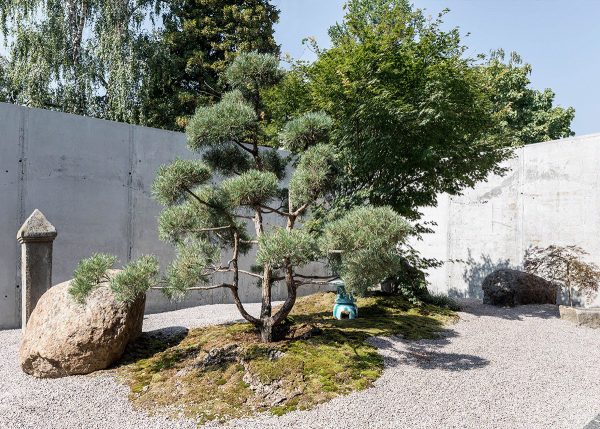
Japanese zen gardens characterise each corner of the site.
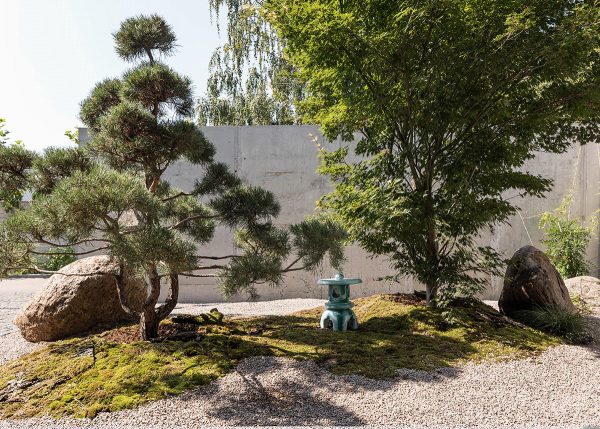
250 Tons of stones, and several perspectives shape the garden.
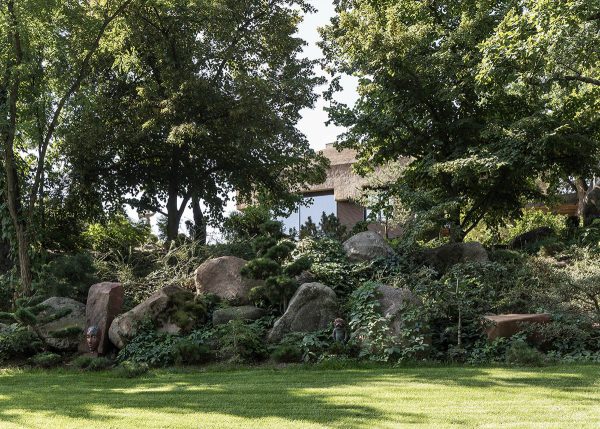
A giant rockery provokes layered foliage.
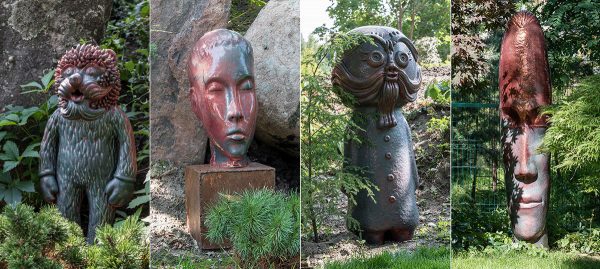
Majestic garden statues and traditional Ukrainian zoomorphic pottery is viewed amongst fragrant conifer and freshly mown herbs.
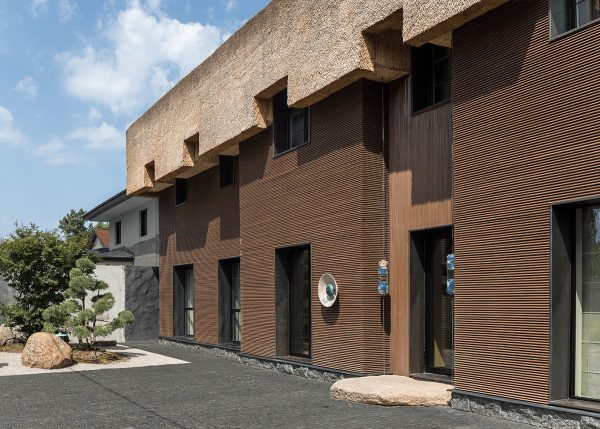
A stone doorstep continues the Zen garden theme.
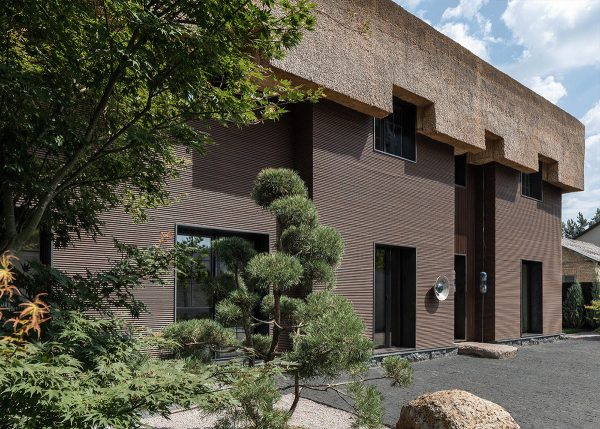
The front entrance of the house stands strong like a fortress, with thatched turrets turned on their heads.
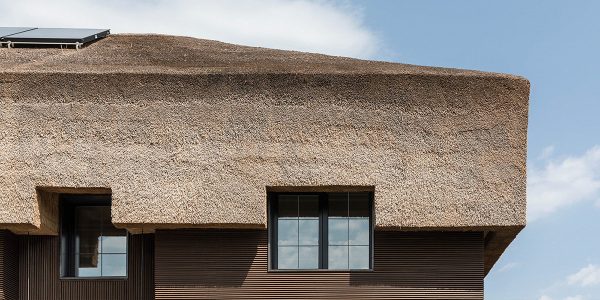
Solar panels perch on the rooftop.
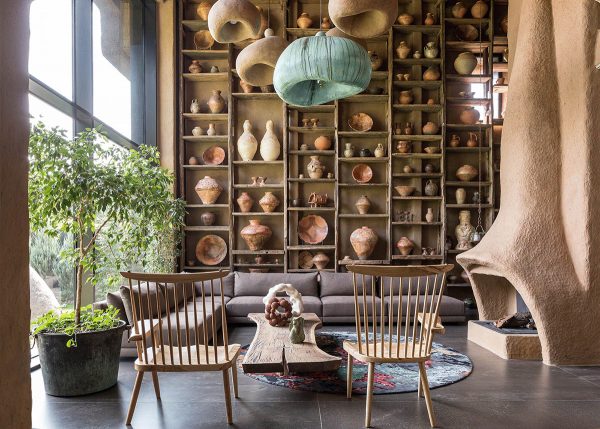
The family wanted an interior that felt like home, rather than a show home. The main focus of this design was not the color of the flooring or the like, but beautiful kids’ noise. Whichever way you plan a modern interior to disguise the craziness of life with kids, life with kids prevails in all its glory. Everything inside this place means something dear to the homeowners, right down to the rug pattern, which was created by middle son Hikaru before he turned 2 years old.
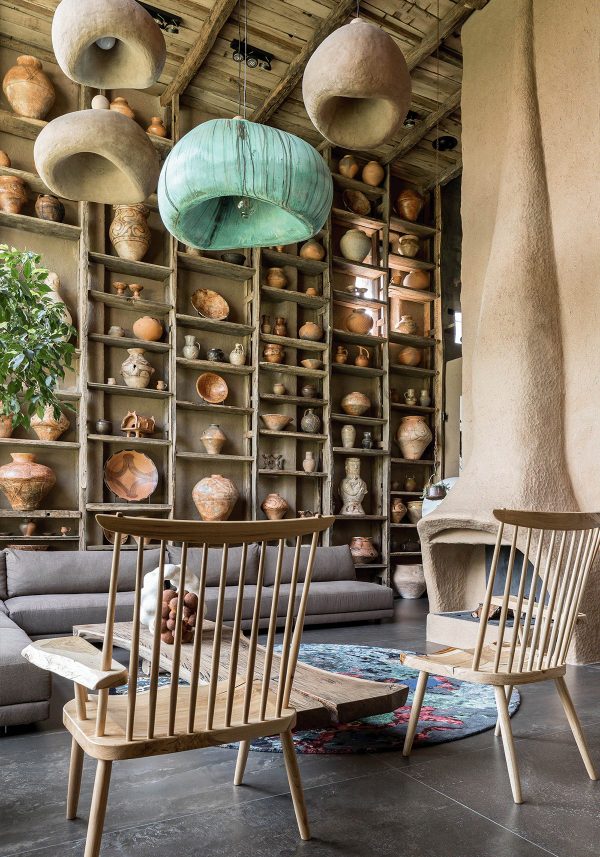
The interior clay wall effect is executed in an ancient technique used in Ukraine for traditional hut building. The wall and ceiling are decorated with wood sourced from eleven old abandoned houses, which is not only uniquely beautiful but wonderfully ecological.
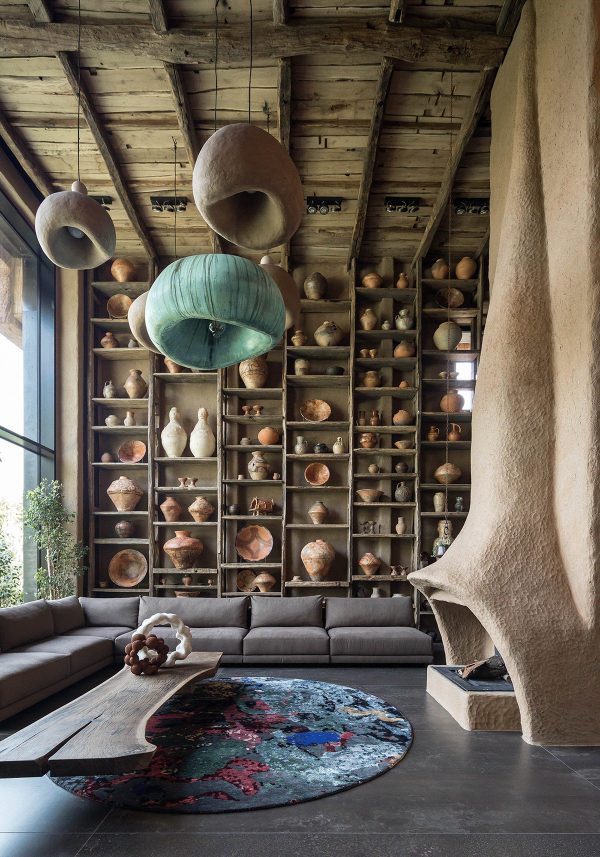
A rustic coffee table is sympathetic to the organic shape of the walls, and to the massive antique ceramic jug collection that fills one wall from floor to high ceiling. Makhno found a love for Ukrainian ceramics as a child, whilst playing in the yard of his grandparents’ house in the village. He found his very first ceramic jugs here, cleaned them up and enthusiastically searched to expand his collection that includes clay products from Trypillia, 5–2nd Millenium BC.
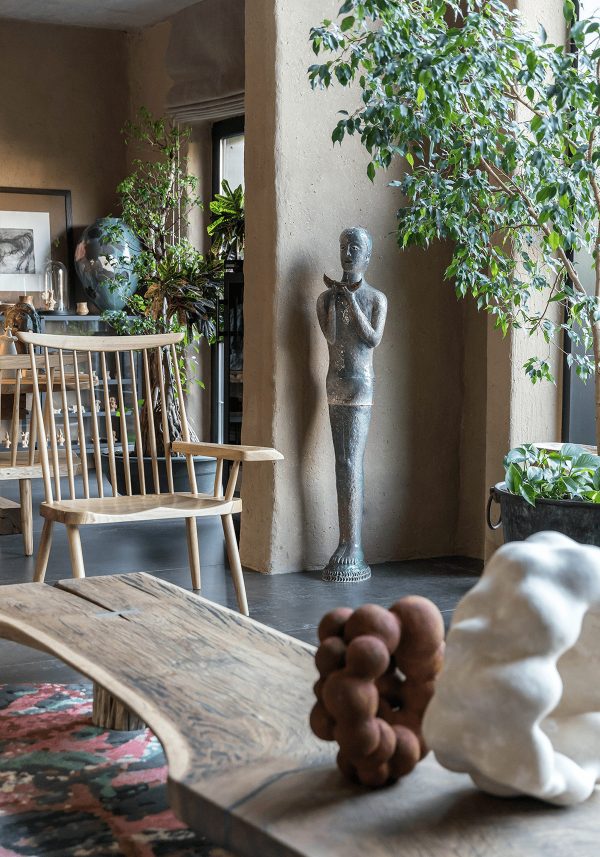
The cool clay walls absorb phone signals and all the worries tied along with.
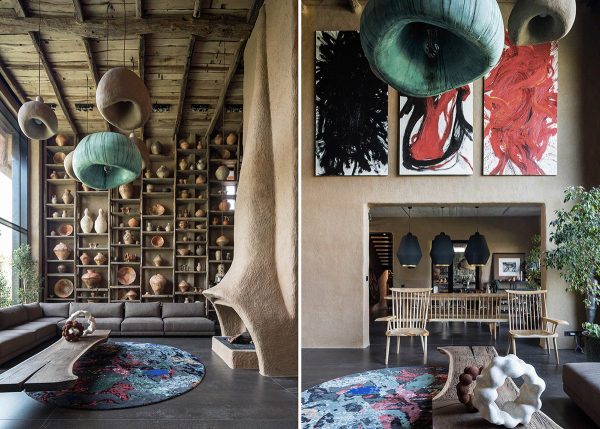
The living space is divided into three parts, which includes an open plan kitchen, dining area, and a lounge.
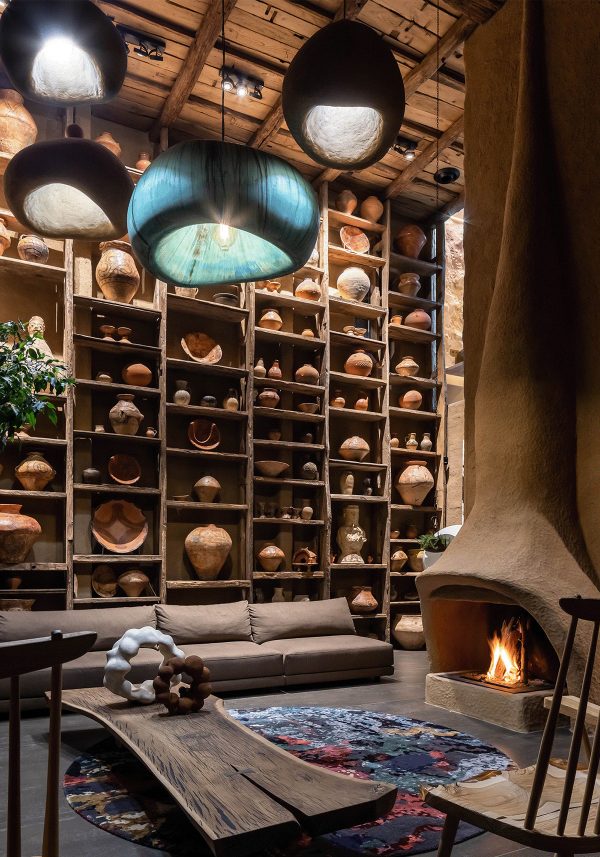
Accents of red and teal add to the warmth of the natural decor.
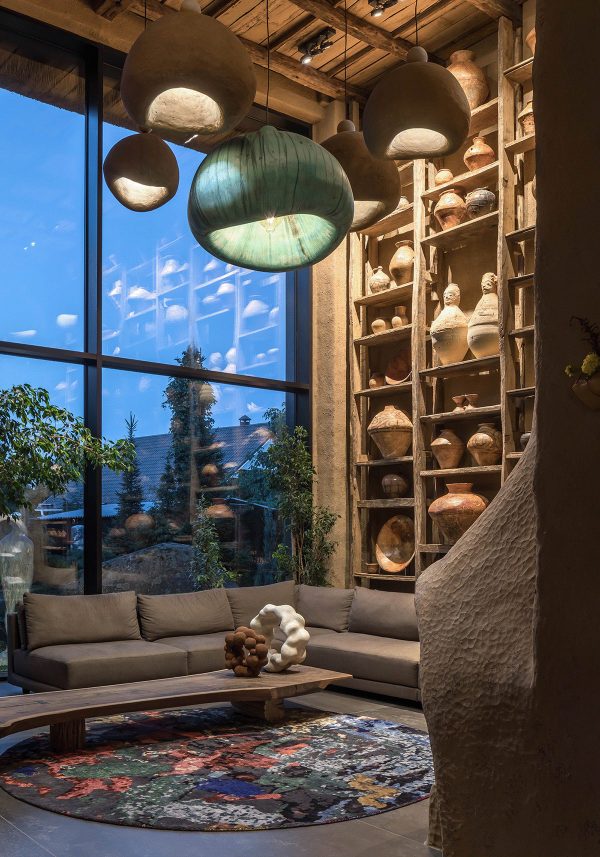
Huge windows bring the garden inside.
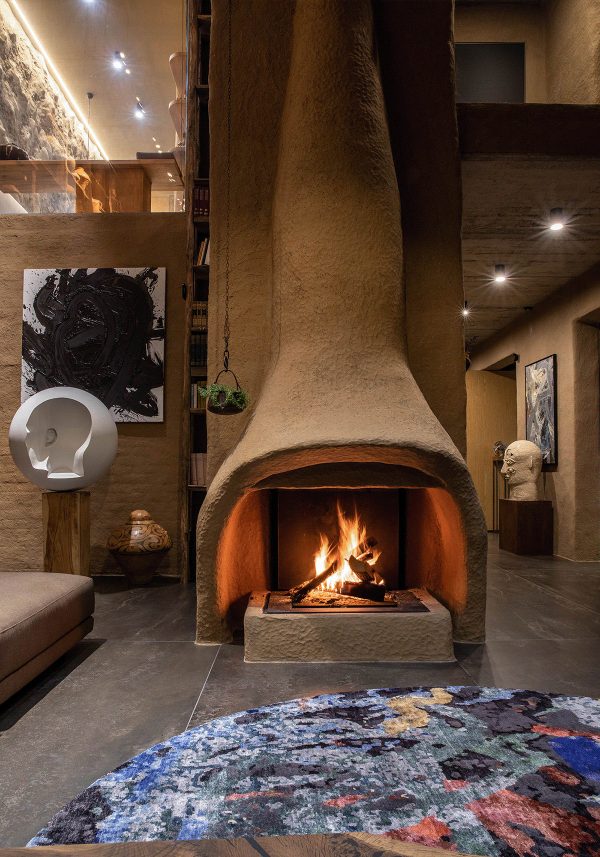
The two floors were united, giving the gift of space and light.
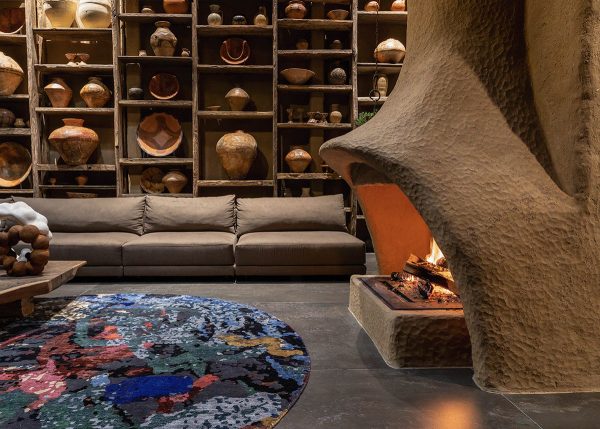
An open fireplace heats the huge expanse.
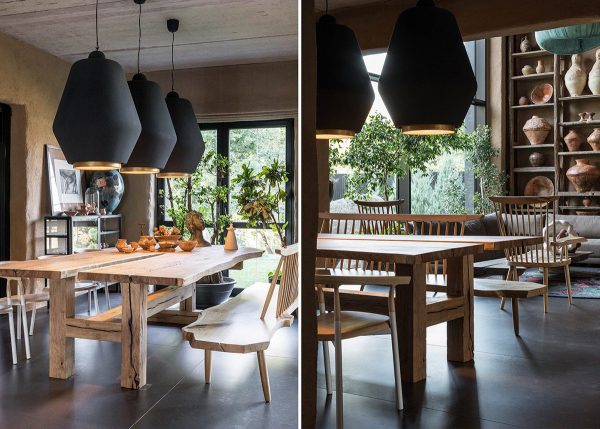
The simple yet warm dining area is the family’s favorite place. Every seat at the table offers a great view, either to the living room, garden or terrace.
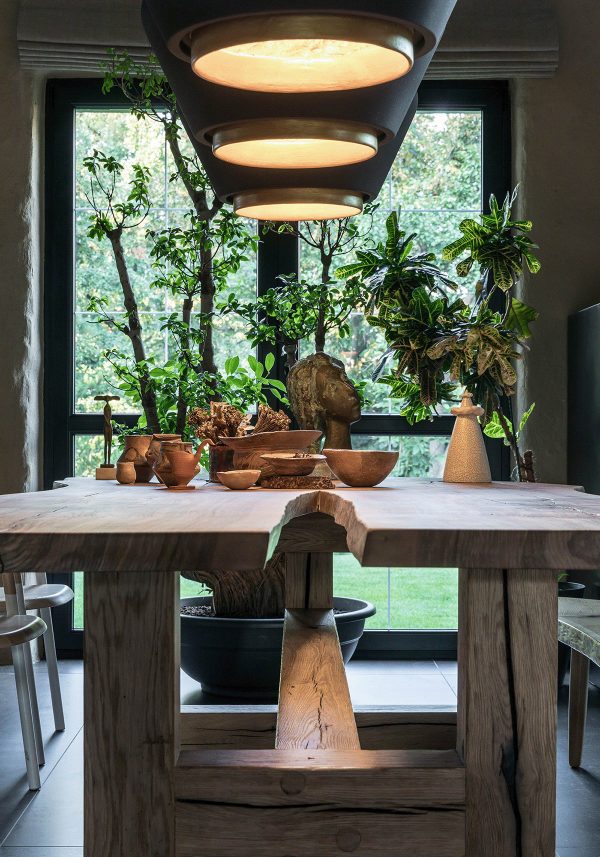
Japanese tea ceremonies hold a special place in the heart of Sergey Makhno, and in this home it is the teacup that reins supreme over the wine glass.
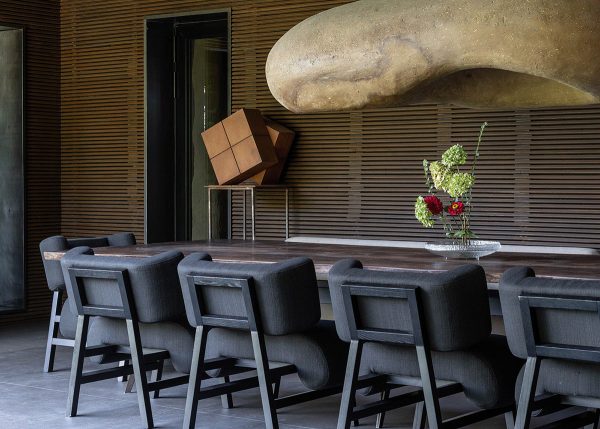
The dining area on the terrace is another special spot, filled with unique pieces.
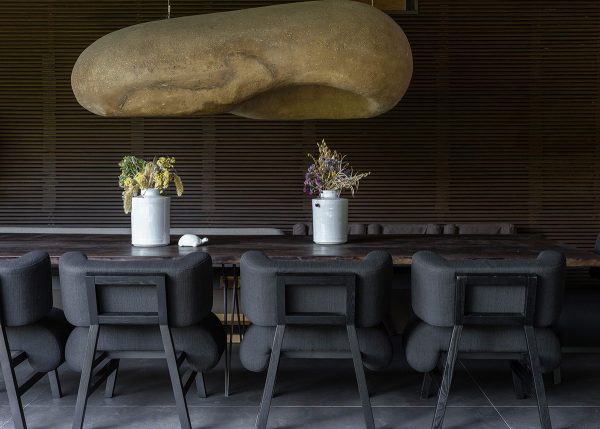
A colossal dining table pendant lamp hovers above chunky modern dining chairs.
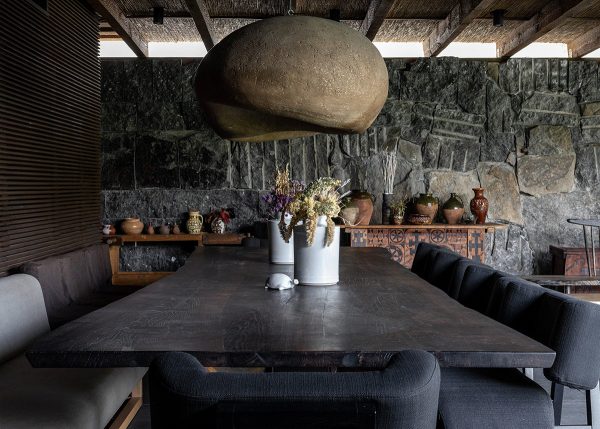
A live edge dining table meanders toward a lesser wall of pottery.
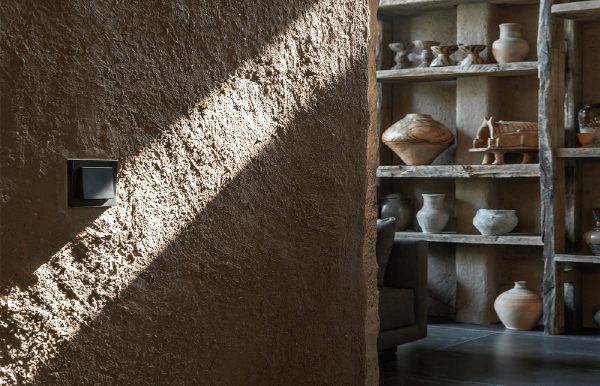
Sunlight plays over deeply textured walls.
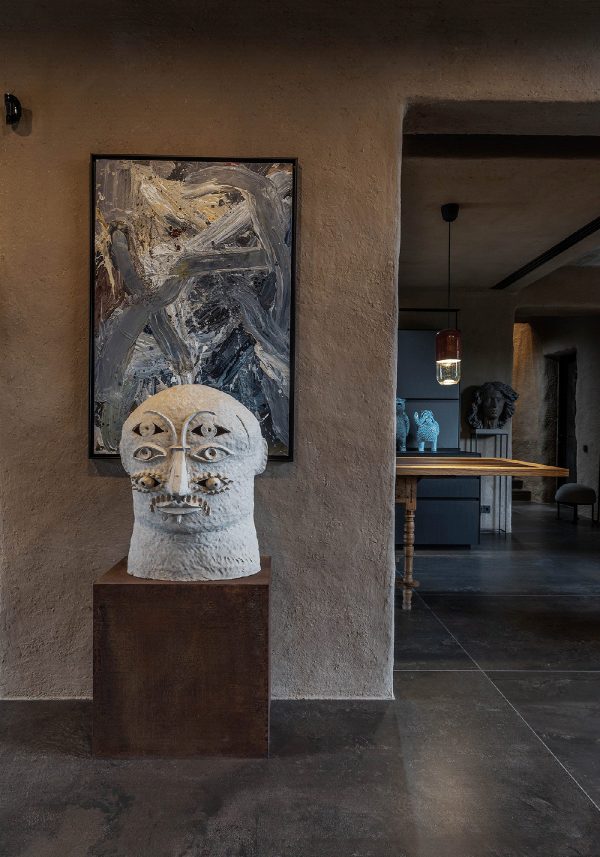
Intriguing artwork stops footfall at every turn.
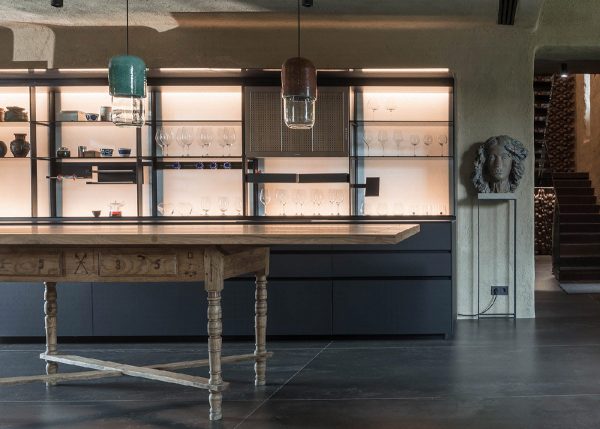
The house is actually equipped with two kitchens. The minimalist kitchen that stands in open plan with the living room is furnished with a contrasting wooden table that was a flea market find.
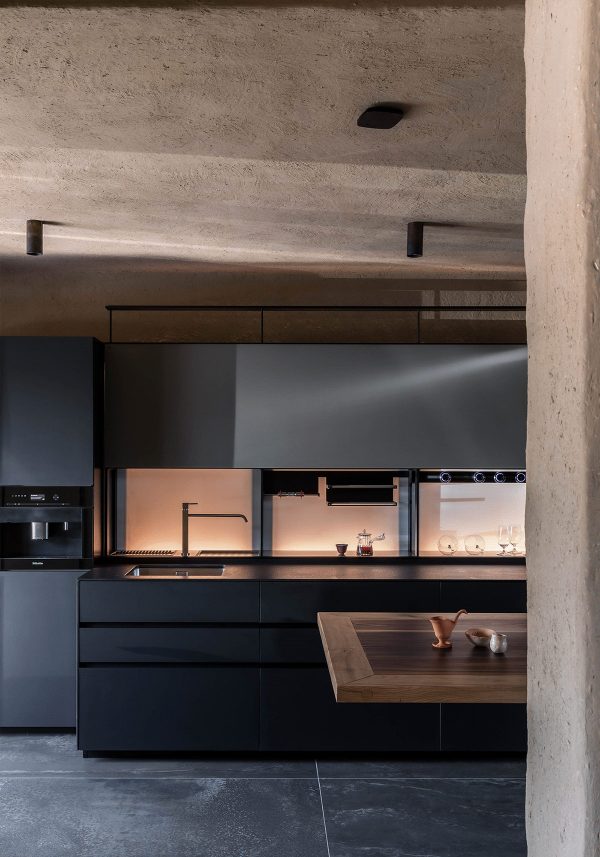
Several generations of Hutsul have dined at this 1935 table, which now stands in lieu of an island in this modern kitchen.
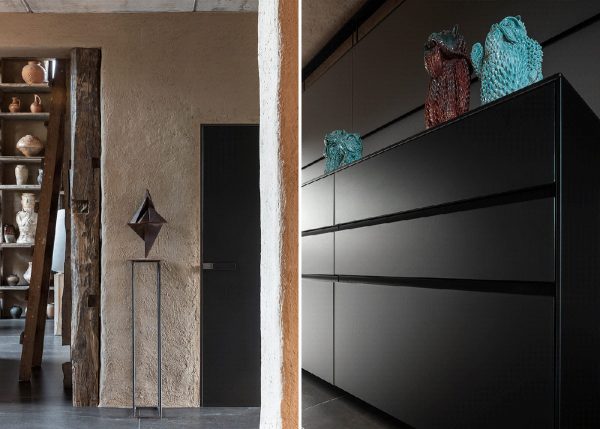
Sleek furniture contrasts against a rugged canvas.
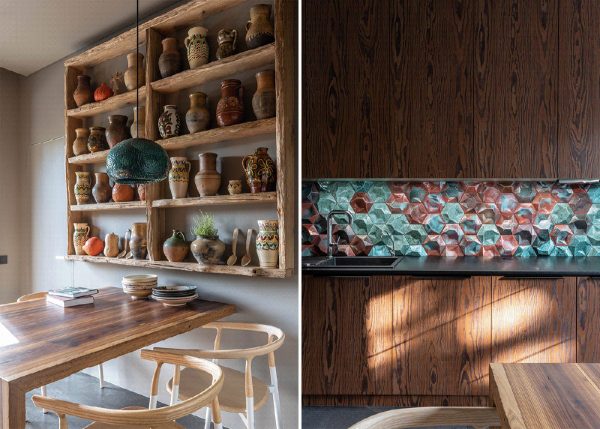
The second kitchen is a closed space that was designed according to Ukrainian traditions.
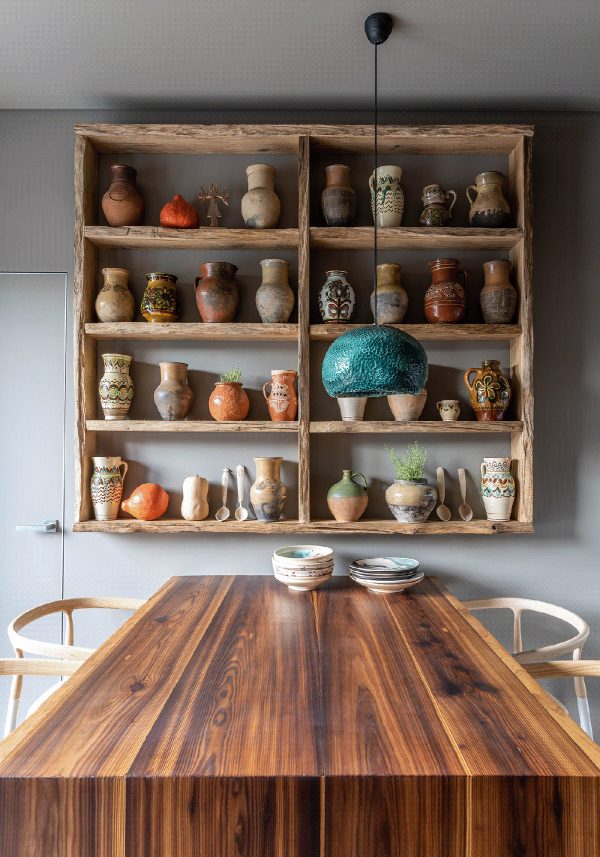
An authentic “mysnyk” is mounted above the table, which is shelves for dishes.
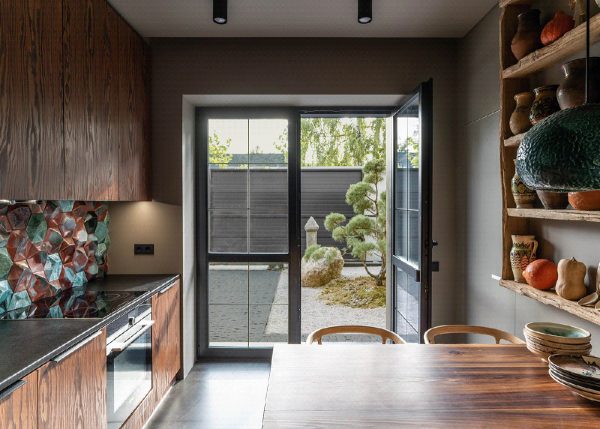
Sergey Makhno ceramic tiles colour the backsplash. An exit to the garden gives a feeling of free-flowing energy.
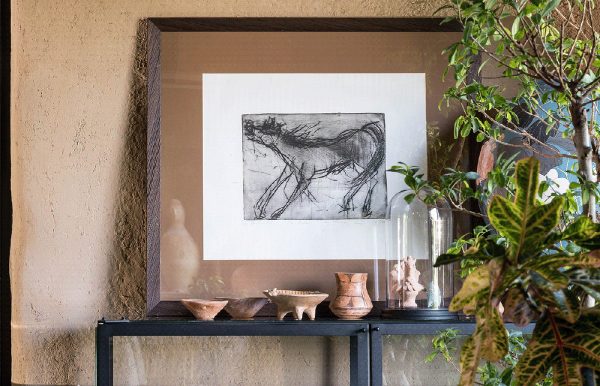
The name of the house, “Shkrub”, is a fictitious word that Sergey and his wife Vlada affectionately call one another, which simply put means love. “It is respect and patience. It is home. It is sons. It is 10 years together”. It is how they are named in each other’s phone books.
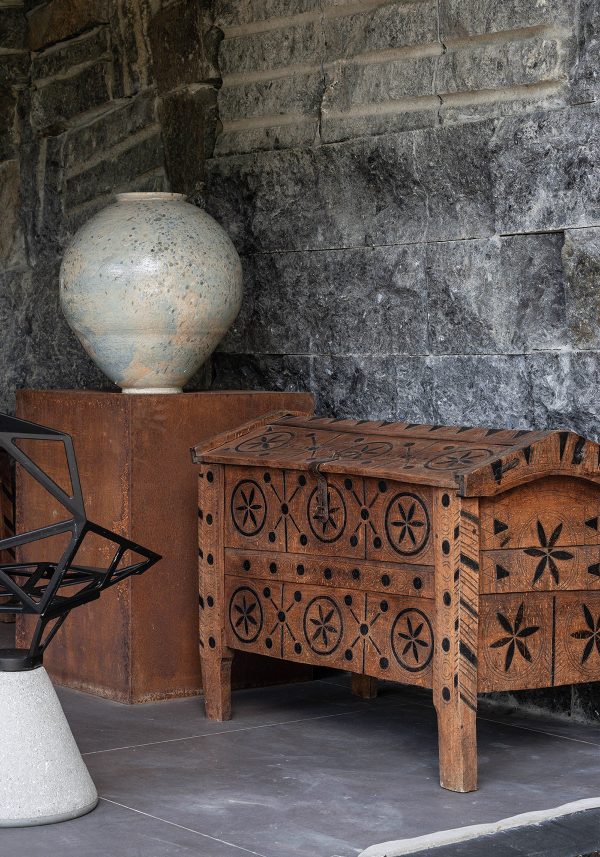
Years of memories paint a personal touch around the home.
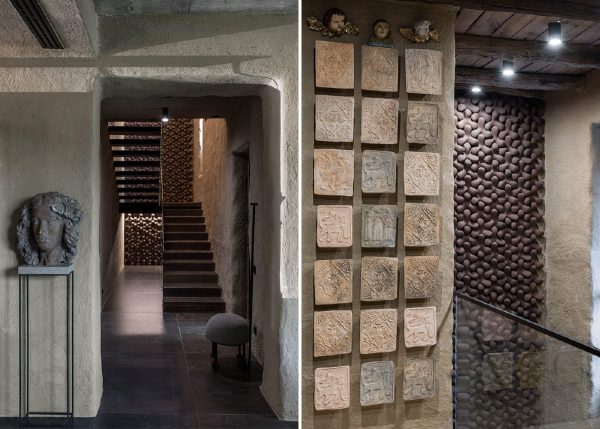
The staircase to the second floor is edged with glass balustrades.
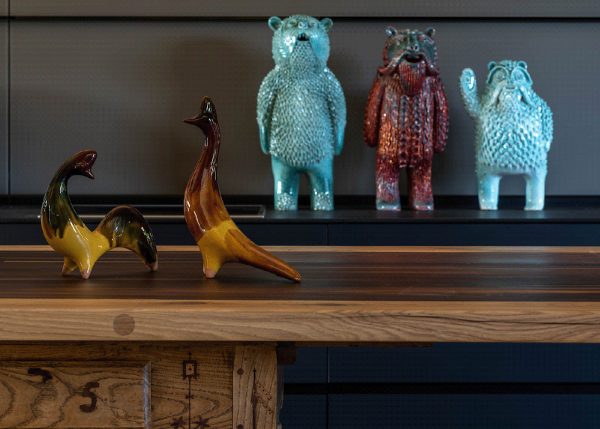
The red and teal touches thread through the entire interior.
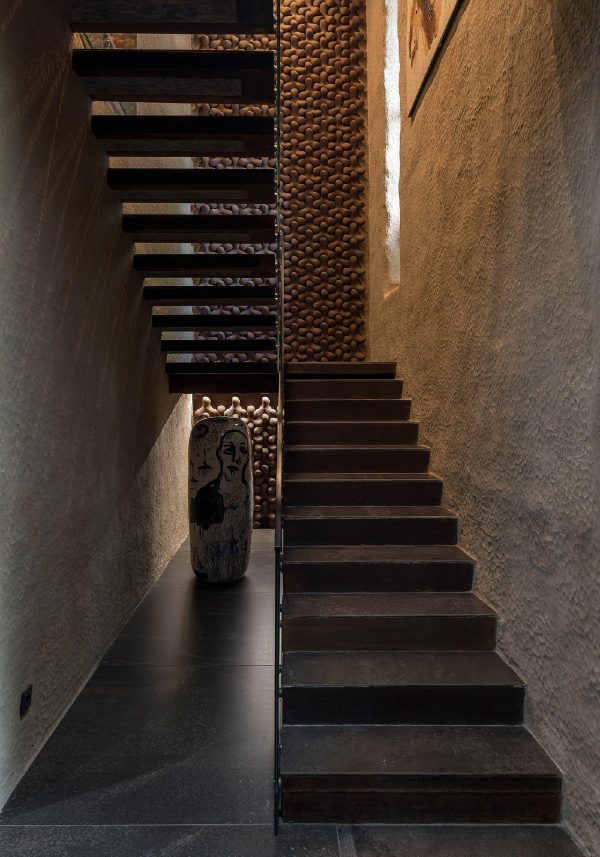
Ginger “Tetrapods”, a designer tile by Sergey Makhno Architects, mark the ascent to the second floor. These attention grabbing tiles were inspired by the massive concrete tetrapods that are installed on coastlines to resist wave impact and prevent beach erosion.
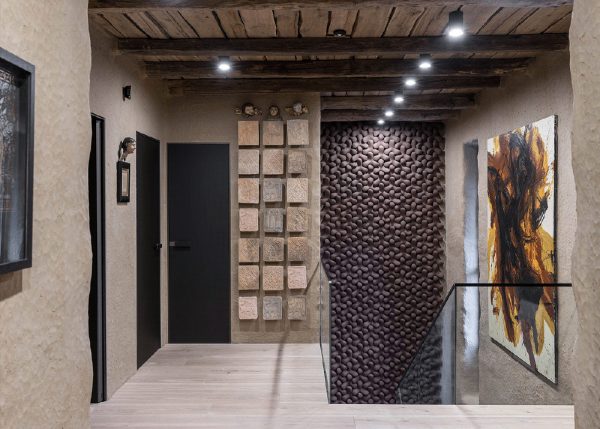
Upstairs, a gallery hall leads to the bedrooms. 16th century ceramic tiles provide decor up here, and guardian angels watch over the doors of the children’s bedrooms.
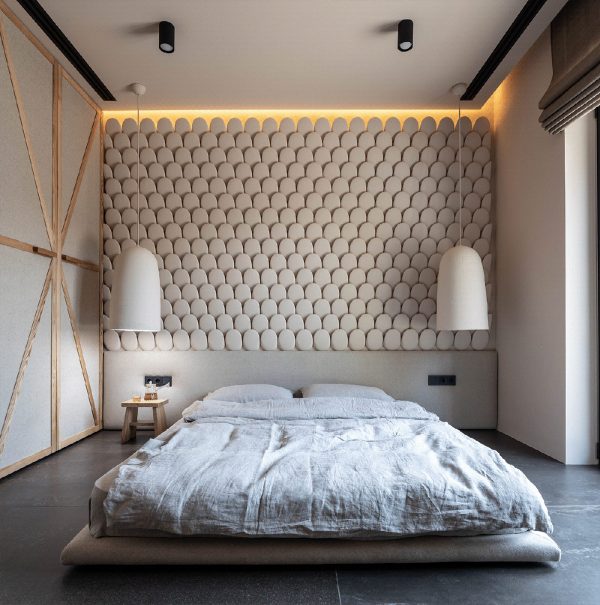
As Sergey’s parents are frequent guests in this house, one of the bedrooms has been dedicated to their stay. The connection between grandchild and grandparent is strong, and in Ukraine it is believed that grandparents love grandchildren more than children. Decor in the grandparents’ room is very simple and restrained. A low Japanese style bed skims the floor, beneath plain yet strong bedroom pendant lights.
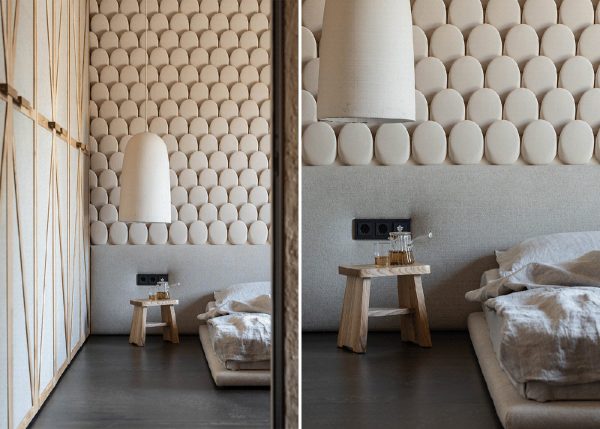
Sculptural tiles fill the headboard wall, accentuated by ambient light.
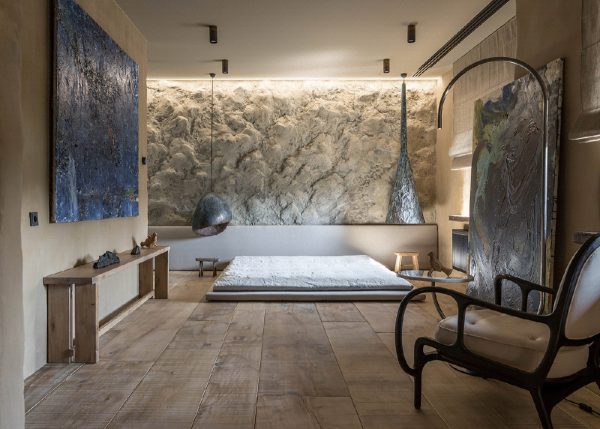
Separate zones make up the master suite: The relax and recreation area, a study, a shower room and bathroom. Here the headboard wall of a tatami bed represents a clay cliff, symbolising primeval beauty, in a unique technique implemented by the Kelsis studio.
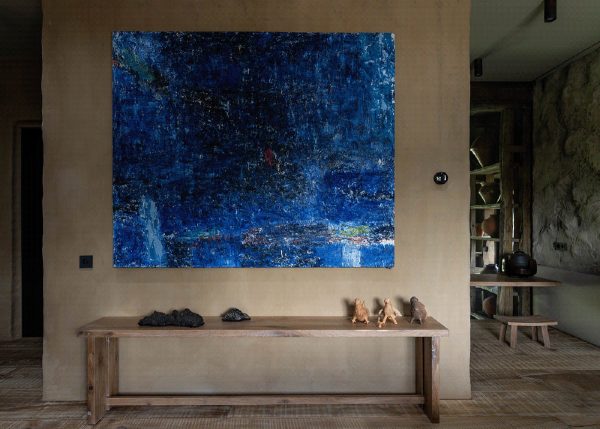
Cobalt blue artwork powerfully disrupts the naturally neutral palette of the room.
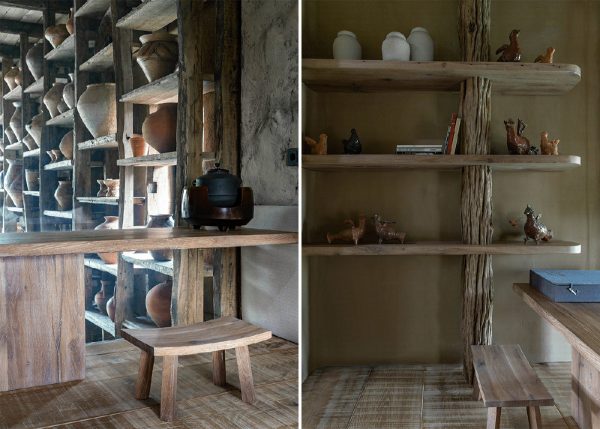
The study area in the master bedroom has a window that looks down over the living room and into the garden.
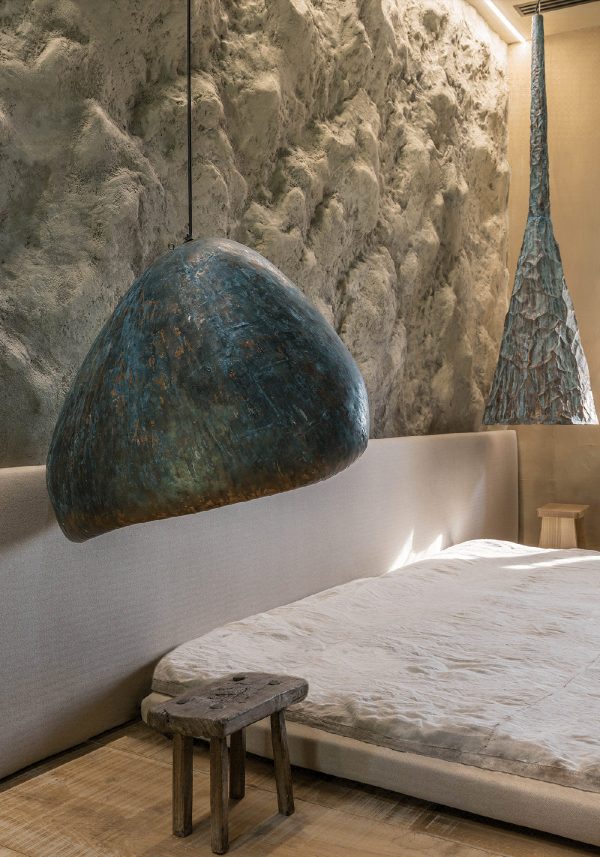
Metal lamps designed by Sergey Makhno Architects studio.
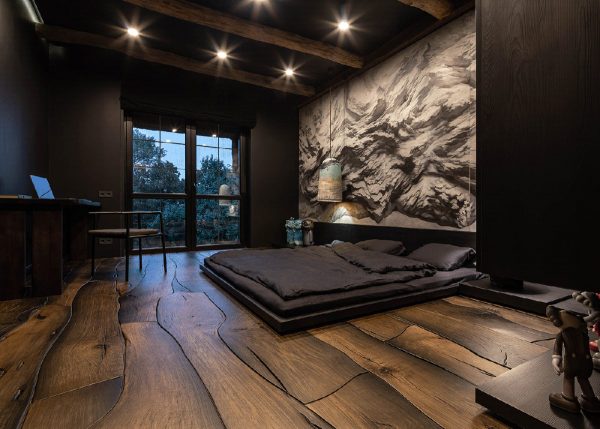
This dramatically dark bedroom scheme belongs to Sergey’s eldest son, Ivan, who is away studying in Italy with a view to continue his father’s business.
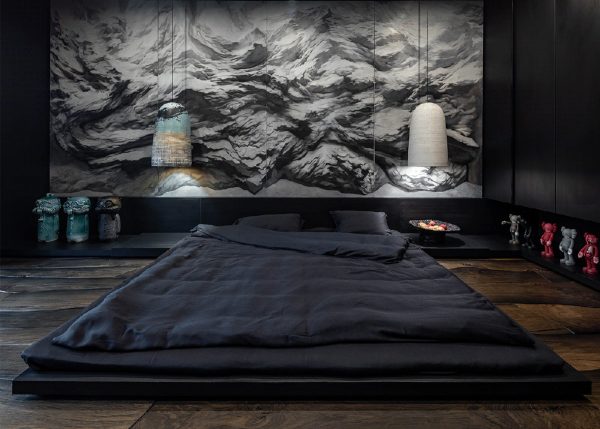
A Sumi-e-style monochrome art piece depicts distant landscapes at the head of the bed, which is traditional in the wabi-sabi philosophy.
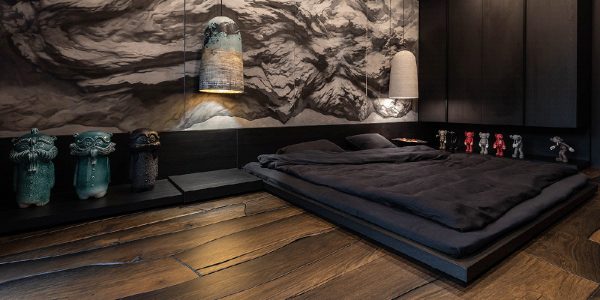
500 year old oak covers the floor.
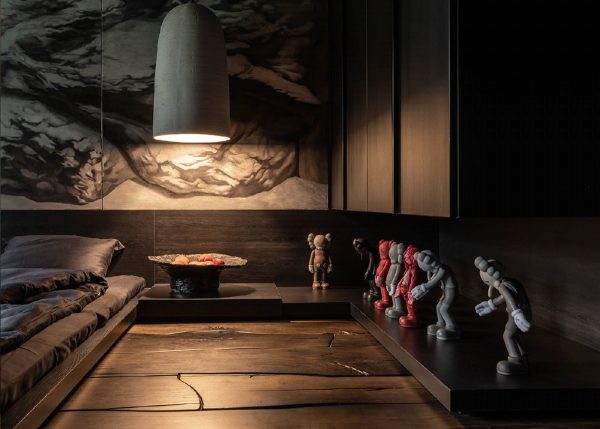
Kaws figurines and ceramic art-toys DIDO decorate Ivan’s room, which were created by his father.
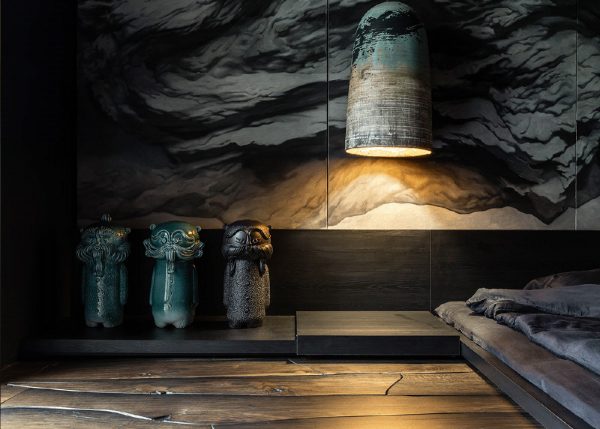
Low bedsides wing the tatami bed.
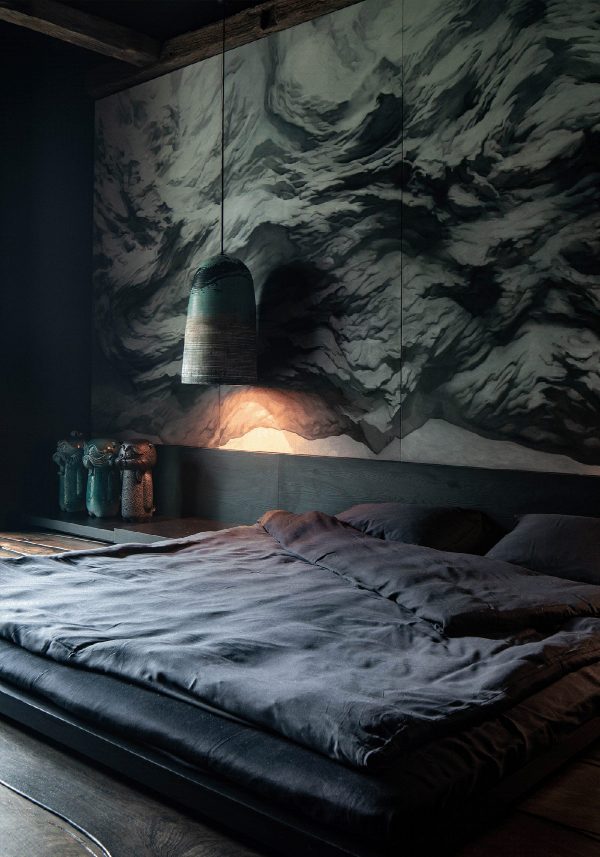
Sergey Makhno Architects lights softly illuminate the moody black decor.
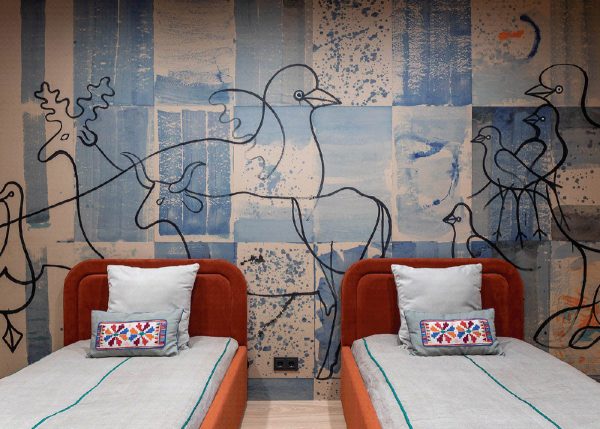
Wallpaper in the shared kids’ room was designed by Sergey Makhno, with chaotic blues spots dashed onto craft paper. Ukranian animals were then painted on by famous Ukrainian artist and ceramist, Serhii Radko.
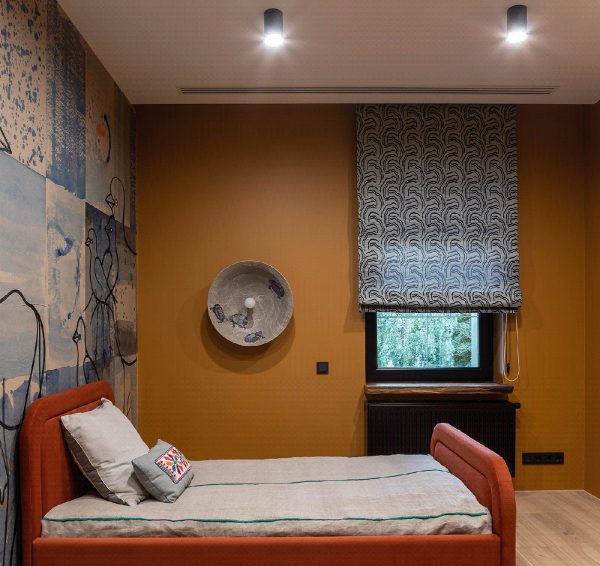
Mustard yellow wall paint contrasts brightly with the blue mural wall.
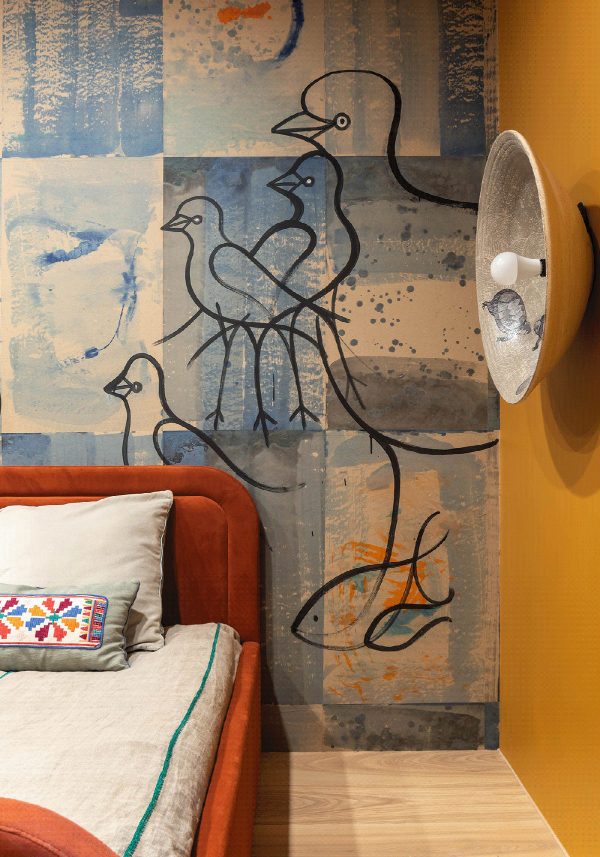
The animals in the wall mural symbolise family.
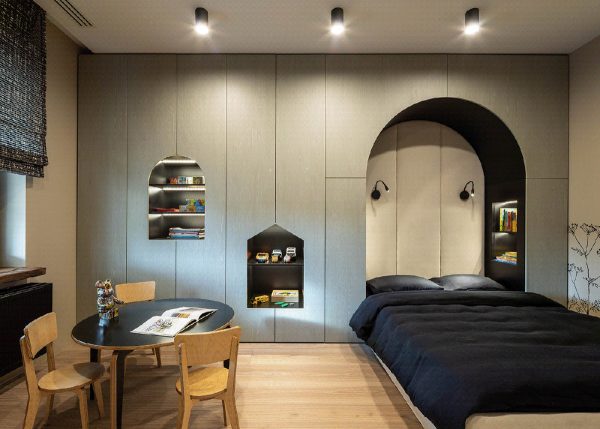
Moving into the final kid’s room, a bespoke storage wall has archways built into it, where special toys can be kept out on display.
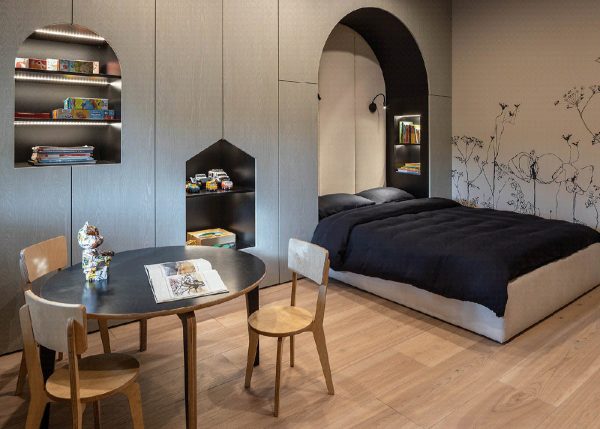
The biggest archway arcs over the bed, with book nooks recessed into each side.
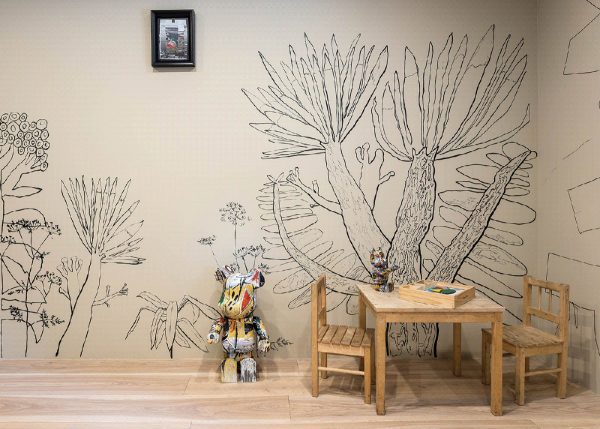
Kid’s spaces were designed to encourage amazing imaginations and free creativity.
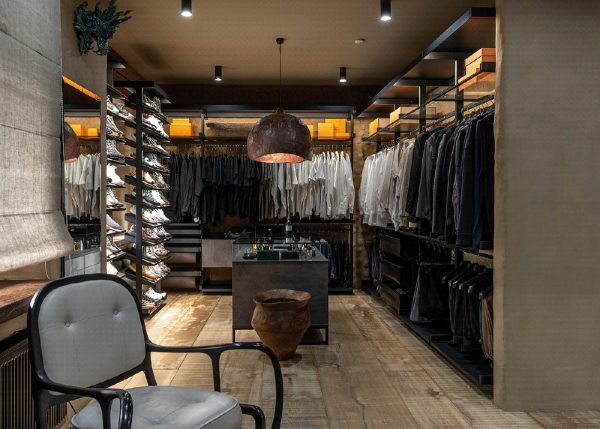
A walk in closet looks like a high-end fashion boutique.
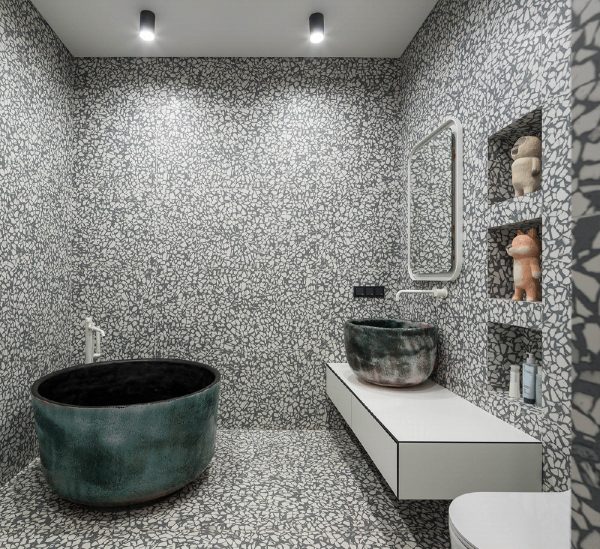
Quirky accessories colour a monochrome bathroom…
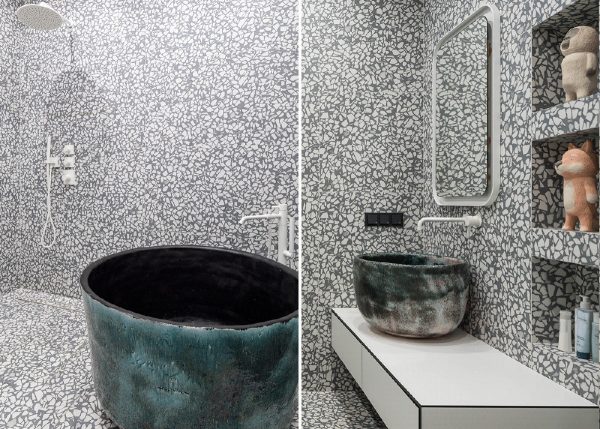
… But it’s the unique bathtub and sink that stand out as hero pieces.
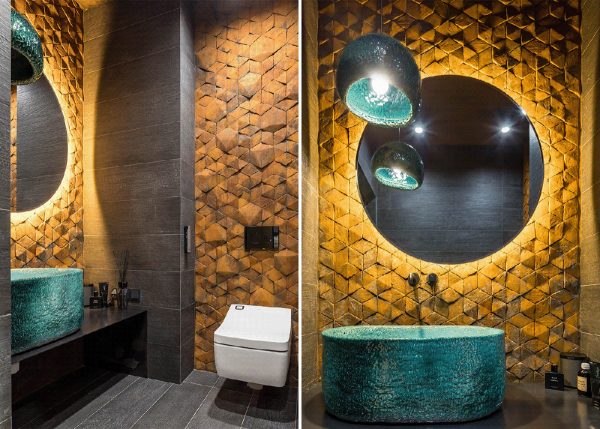
Another show-stopping bathroom basin puts a splash of teal up against a bright yellow tile wall.
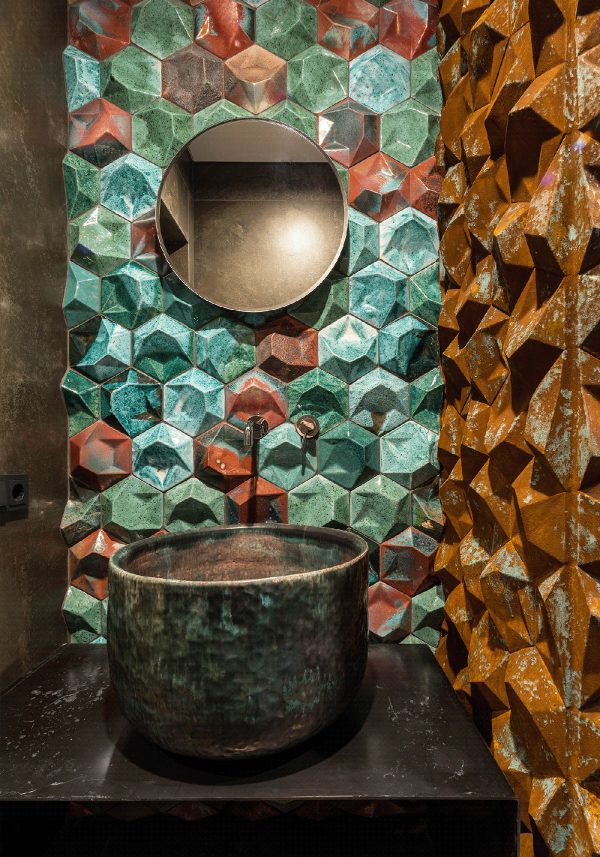
This creative use of copper is designer tiles by Sergey Makhno, which decorate the guest bathroom.
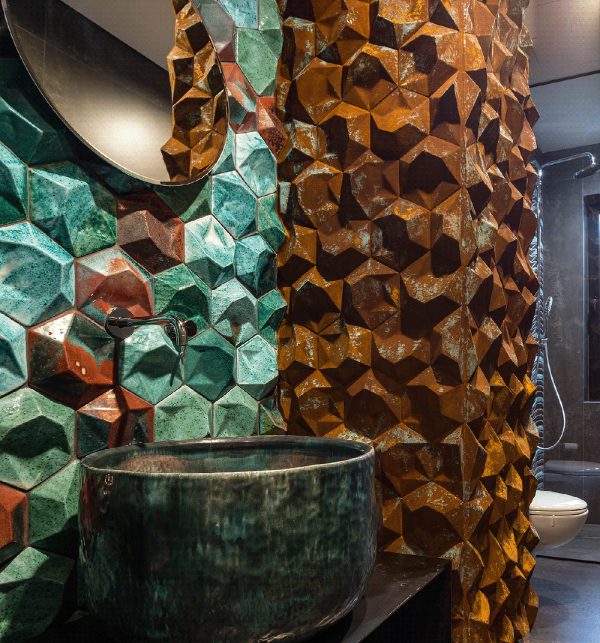
Two versions of “Grass” and “Earthquake” tiles fill the walls around the vanity.
Recommended Reading: A Terraced Japanese Garden House Filled With Sculptural Art
Related Posts:
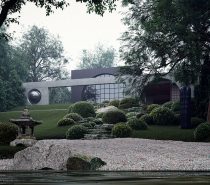 A Terraced Japanese Garden House Filled With Sculptural Art
A Terraced Japanese Garden House Filled With Sculptural Art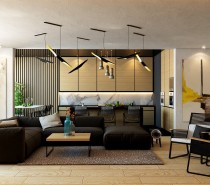 Wood Slats Add Texture and Warmth to These Homes
Wood Slats Add Texture and Warmth to These Homes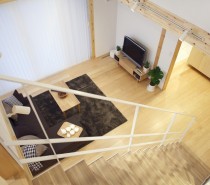 Simple Open Plan Living
Simple Open Plan Living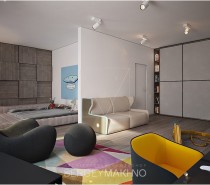 Kiev Apartment Showcases Sleek Design with Surprising Playful Elements
Kiev Apartment Showcases Sleek Design with Surprising Playful Elements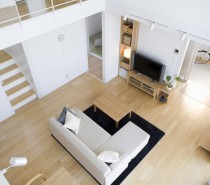 Minimalist Japanese Prefab House
Minimalist Japanese Prefab House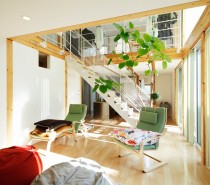 Japanese Style Interior Design
Japanese Style Interior Design
Source: https://ift.tt/342HPPN
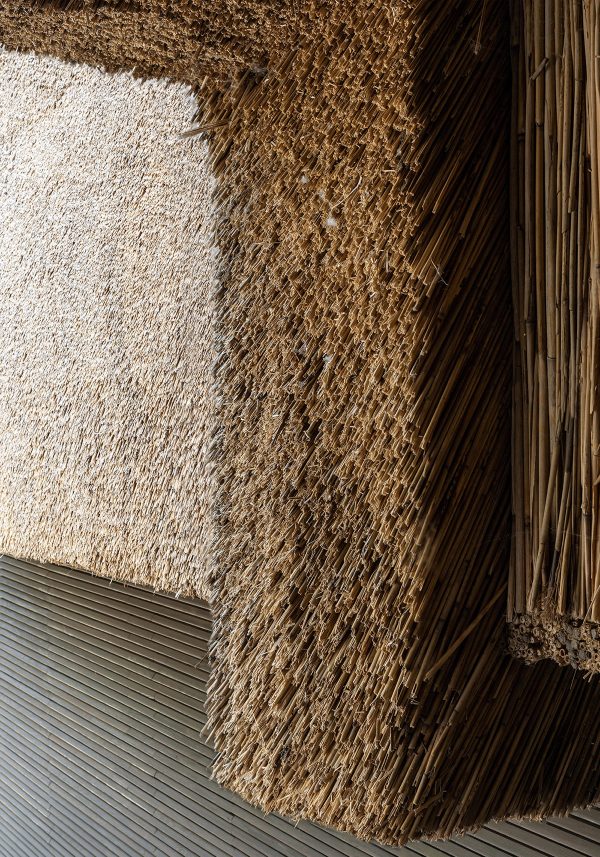
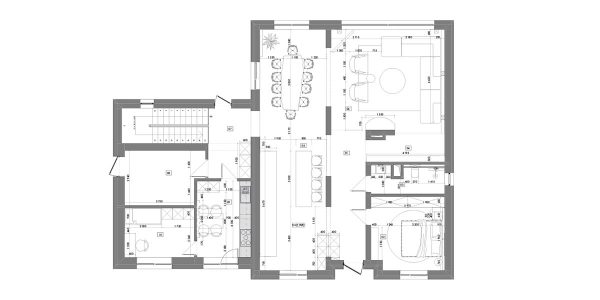
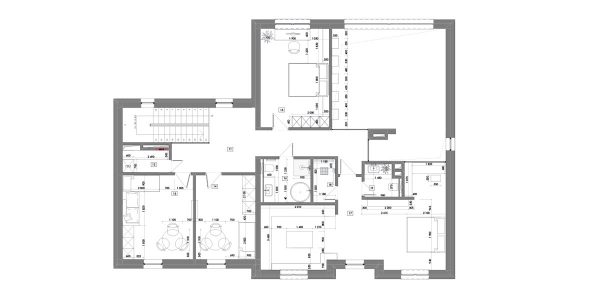
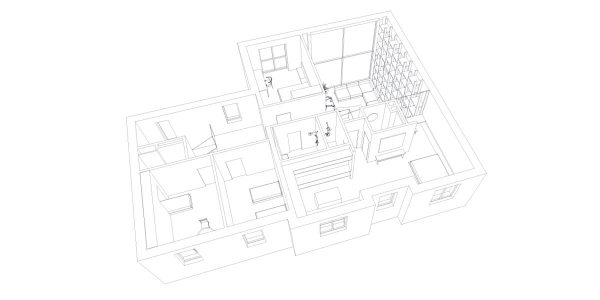
No comments:
Post a Comment